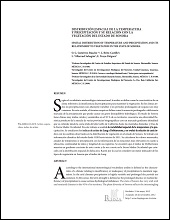DISTRIBUCIÓN ESPACIAL DE LA TEMPERATURA Y PRECIPITACIÓN Y SU RELACIÓN CON LA VEGETACIÓN DEL ESTADO DE SONORA
SPATIAL DISTRIBUTION OF TEMPERATURE AND PRECIPITATION AND ITS RELATIONSHIP TO VEGETATION IN THE STATE OF SONORA
Autor
OSCAR GERARDO GUTIERREZ RUACHO
LUIS BRITO CASTILLO
LEOPOLDO VILLARRUEL SAHAGUN
ENRIQUE TROYO DIEGUEZ
Metadatos
Mostrar el registro completo del ítemResumen
"Según el vocabulario meteorológico internacional, la aridez se define como la característica de un clima referente a la insuficiencia de precipitación para mantener la vegetación. En los climas áridos las precipitaciones son altamente variables y los periodos prolongados de sequías son muy comunes. En este sentido, el término sequía se define como la ausencia prolongada o deficiencia marcada de la precipitación que puede causar un grave desequilibrio hidrológico. El estado de Sonora tiene climas muy áridos, áridos y semiáridos en el 95 % de su territorio; concentra una diversidad florística producto de la mezcla de varias provincias biogeográficas con un marcado gradiente altitudinal que se extiende desde la costa árida del alto Golfo de California hasta las montañas húmedas y frías de la Sierra Madre Occidental. En este trabajo se analizó la variabilidad espacial ó de la temperatura y la precipitación. Se estudiaron los índices de aridez de Lang y DeMartonne, y se evaluó la relación de cada índice con los cambios observados en la distribución de vegetación en el estado de Sonora. Se trabajó con información climática del estado desde 1920 hasta inicios de 2011. Se calcularon los valores mensuales, anuales de temperatura y precipitación con la información de las estaciones más relevantes en cuanto a ubicación, continuidad de datos y longitud de sus registros. Se encontró que el índice de DeMartonne muestra un gradiente creciente de este a oeste y de sur a norte en la Sierra Madre Occidental que coincide con la distribución espacial de dicha área. Razón por la cual se consideró un mejor indicador de los tipos de vegetación en Sonora que el índice de Lang." "According to the international meteorological vocabulary aridity is defined as the characteristic of a climate relating to insufficiency or inadequacy of precipitation to maintain vegetation. In the arid climates precipitation is highly variable and prolonged dry periods are common. In this sense, the term drought is defined as the prolonged absence or marked deficiency of precipitation to cause serious hydrological imbalance. The state of Sonora has very arid, arid and semiarid climates in the 95% of its territory. The plant diversity of Sonora reflects the intermingling of several major biogeographic provinces. There is a mark altitudinal gradient of vegetation types in Sonora extending from the hot, arid coast of the upper Gulf of California to the wet, cold highlands of the Sierra Madre Occidental.In this work we performed the analyses of the spatial variability of temperature and precipitation in Sonora. The aridity indices of Lang and DeMartone were studied and their link to observed changes in the distribution of vegetation was evaluated. We used climatic data of Sonora between 1920 and 2011. Long-term means of temperature and precipitation were estimated from selected climatic stations according to their location, continuity and length of their records. It was found that De Martonne`s index increases from east to west and from south to north in the Sierra Madre Occidental coincident with the spatial distribution of vegetation. For this reason, De Martonne`s index was considered better indicator than Lang index for the vegetation types in the state Sonora."
Colecciones
Ítems relacionados
Mostrando ítems relacionados por Título, autor o materia.
-
PROMOCIÓN DEL PERIFITON PARA EL CULTIVO DE CAMARÓN BLANCO: HACIA UNA ACUICULTURA ECOLÓGICA
DOMENICO VOLTOLINA LOBINA; JUAN MANUEL AUDELO NARANJO; MARIA DEL ROSARIO PACHECO MARGES -
Suelo y Erosión
YOLANDA LOURDES MAYA DELGADO


